|
|
 |
|
|
|
 |
 |
|
|
 |
Context: The role of phytoplankton and humans in the oceanic environment
|
Key words:
phytoplankton, algae, food chain, predators, eutrophication, dimethylsulfide, climate feedback | |
|
Marine food-webs
71% of the Earth's surface is covered by ocean. Although we might first of all think about water when we hear ocean, we however know that it is a giant ecosystem. In the same way as for the plants and animals on the continents there are also food-webs in the oceans. Phytoplankton plays the same role in the sea as forests and grasslands play on land. Phytoplankton is single-celled algae which floats in the oceans. It conducts photosynthesis as land plants do and forms biomass from carbon dioxide and water with the help of light and nutrients.
|
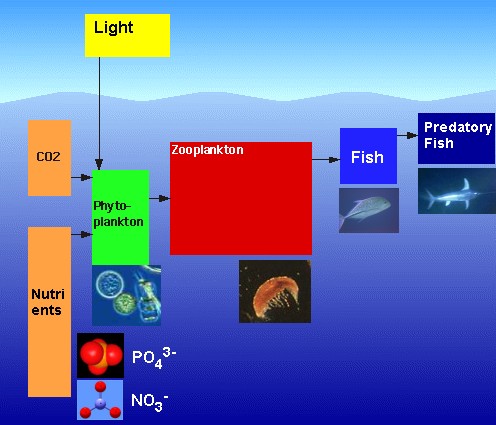 |
 |
|
1. The marine food-web, one species feeds the next
|
Phytoplanktion serves as nutrition for tiny animals in the ocean, for example little shellfish, which float in the water. We call them zooplankton. All small organisms floating in the sea, either plants or animals, are called plankton. They are eaten by fish. Smaller fish in turn are eaten by carnivorous fish. Humans are also big predators in the marine food chain. Although we do not live in the oceans ourselves, we exploit them with little fishing cutters and big trawlers.
|
 |
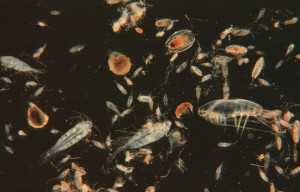 |
 |
|
2. Zooplankton are tiny animals floating in the water, for example little shellfish
Please click the photo for a larger version. (100 K)
|
|
|
Humans interfere as predators in the marine food-web
Fishing with trawl nets can be a major burden for the marine life. Some species are hunted until their survival is in danger. Mammals like dolphins die as unwanted by-catch in the nets. Moreover, not all fish caught can be sold and less valuable dead fish are thrown back to the sea.
|
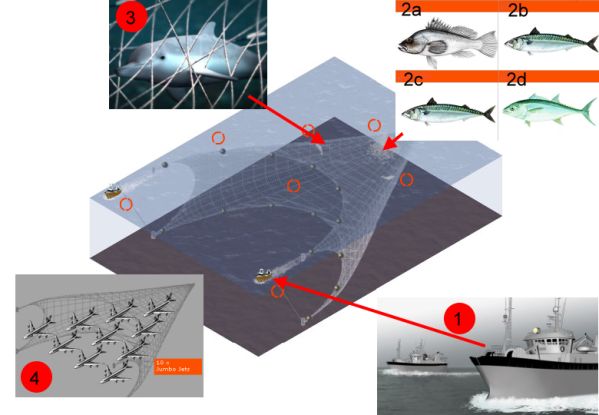 |
 |
|
3. Trawling - a predatory activitiy of humans in the ocean
- (1) In pair-trawling, two boats are used in order to tow one big net
- (2) Typical sea fish serving for us as food are a) sea bass b) mackerel c) tuna d) herring
- (3) Often other animals like dolphins die in the net as by-catch
- (4) Nets can be as large as 120 x 60 m
Source: Images are taken from a flash animation of the Greenpeace ocean campaign
|
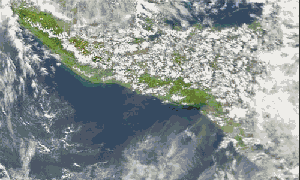 |
 |
|
4. Algae bloom at the coast of El Salvador. The first and second picture are true colour pictures (dark and light), the following show a coloured visualisation of the algae based on clorophyll measurements. Intensity increases from blue via green and yellow to red. Chlorophyll is the green plant pigment necessary for photosynthesis.
Please click the image for a slower high resolution animation. (300 K)
Source: original pictures from NASA, animation by Elmar Uherek
|
|
 |
Humans interfere as a provider of nutrients
Humans are not only predators, they also change the natural equilibrium of nutrients in the sea, in particular next to the coasts. For photosynthesis, phytoplankton needs not only carbon dioxide and water but also nutrients: nitrate, phosphate, iron. We do not only fertilize our fields, but also the sea with such nutrients because we discharge - being aware of it or not - residues of fertilizers from agriculture or waste waters into the oceans.
|
Large amounts of nutrients can foster the growth and bloom of huge amounts of phytoplankton. When the phytoplankton has finished its short life cycle, it is decomposed by bacteria which use up plenty of oxygen. Fish can die in such cases from lack of oxygen in the water. We call it "eutrophication" when humans overload the water of lakes or oceans with too much fertilizers or waste.
|
 |
 |
 |
|
5. Eutrophication at Potomac River Delta © NOAA
|
|
|
Phytoplankton and the climate
Not only the forest but also phytoplankton plays an important role for our climate. Since these little algae grow from photosynthesis, they use up carbon dioxide. Due to phytoplankton the oceans take up about one third of all carbon dioxide we emit as greenhouse gases to the air. Therefore, phytoplankton helps to mitigate global warming.
|
|
|
 |
6. Human interaction with the marine environment: 1) fertilizers and waste waters bring in nutrients 2) the increase of carbon dioxide in the air leads to an uptake by the oceans 3) more CO2 decreases the pH 4) the temperature of air and ocean increase due to global warming 5) intensive fishing diminishes the fish population
Click the image for a higher resolution. (145 K) |
Phytoplankton does not only take up gases. It also produces gases, in particular sulphur-containing organic gases. One of them, which is indirectly formed, is dimethylsulfide (DMS). The plants use the precursor of DMS, dimethylsulfonioproprionate (DMSP), as a signal compound and for osmoregulation. DMS is important for the climate system since it is emitted into the air in large amounts. It is then oxidized and forms little droplets of sulfuric acid. Clouds form because water condenses on these droplets. Therefore, gases coming from phytoplankton are the most important source of clouds above the ocean and also the most important natural source of sulphur in the air, previous to volcanoes. It may be possible that changes in the marine food chains also influence climate change.
|
 |
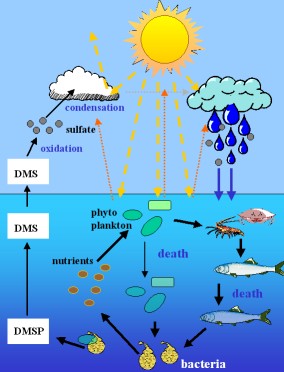 |
 |
|
7. The role of phytoplankton and other chemical and living species in the cycle of ocean life and weather. Please click for a high resolution image! (135 K)
Scheme: Elmar Uherek
|
|
Author: Elmar Uherek - Max Planck Institute for Chemistry, Mainz
Reviewer: Tom Bell - University of East Anglia, Norwich
|
|
 |
|







